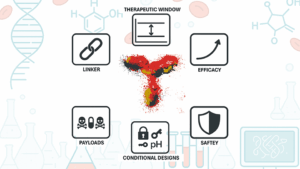
Tubulis presents first clinical data on ADC TUB-040
Following its US$361 m Series C financing, Tubulis AG presented first Phase I/IIa data on its lead ADC, TUB-040, at ESMO 2025 in Berlin. The study focuseds on patients with platinum-resistant ovarian cancer (PROC). TUB-040 shows clear differentiation potential
Overall, around 50% of all recurrent ovarian cancers are platinum-resistant. The market is expected to grow from about US$3.3bn in 2022 to US$5.6bn by 2030.
Tubulis’ ADC TUB-040, targeting the NaPi2b cancer antigen, showed typical ADC activity in 66 patients with platinum-resistant high-grade serous ovarian cancer (PROC-HGSOC), alongside a very favourable safety profile. At doses of 1.67–3.3 mg/kg, the overall response rate (ORR) in fourth-line therapy was 50%, with a confirmed ORR (cORR) of 59%. The confirmed disease control rate (DCR) was 96% as of 1 September, and treatment continues in 93% of responders.
Almost exclusively low-grade adverse events were observed. This is the key differentiator of TUB-040 compared with other topoisomerase‑I ADCs: there were no clinically relevant bleeding events, pneumonitis, ocular toxicity, stomatitis or neuropathy. Haematologic toxicity was mostly low-grade and manageable. The most common Grade 3–4 adverse events were neutropenia (22%), anaemia (9%), thrombocytopenia (4%), and nausea (4%). The maximum tolerated dose (MTD) was 4.4 mg/kg. There were no study discontinuations or deaths.
Tubulis regards these interim results as a proof-of-concept (PoC) for its Tubutecan platform.
“Thanks to our recent financing, we are able to rapidly advance TUB-040 into pivotal trials and expand its clinical development to earlier disease stages and additional tumour types,” said Dr Dominik Schumacher, CEO and co-founder of Tubulis.
Competitive Landscape
Chinese company Alphamab Oncology Co Ltd also presented new Phase I/II data at ESMO 2025 on its biparatopic HER2 ADC JSKN003-102 in 45 PROC patients. At a three-weekly dose of 6.3 mg/kg, the overall response rate was 32%, the disease control rate (DCR) was 72%, median progression-free survival (PFS) was 4.1 months, and 65.4% of patients receiving JSKN003-102 as third-line therapy survived 9 months. The safety profile was acceptable, with no deaths, only low-grade pneumonitis and neurotoxicity. 15.4% of patients experienced Grade 3+ adverse events.
Merck & Co, known as MSD in Europe, and Daiichi Sankyo presented Phase II data on the CHD6-targeting HER3 ADC Raludotatug-Deruxtecan in platinum-resistant ovarian cancer. Across all doses (4.8 mg/kg, 5.6 mg/kg, 6.4 mg/kg), the confirmed ORR in 107 patients was 51%, significantly above the 46% observed in the previous Phase I study. The 5.6 mg/kg dose, with an ORR of 50%, offered the best risk–benefit profile. Regarding safety, there were three treatment-related interstitial lung disease events, a known toxicity of Deruxtecan-based ADCs.



 Yumab GmbH
Yumab GmbH Die Hoffotografen GmbH
Die Hoffotografen GmbH